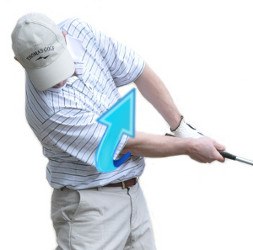
In golf, the term “chicken wing” refers to a specific swing fault or position of the arms during the follow-through phase of the golf swing. It occurs when the lead arm (left arm for a right-handed golfer, right arm for a left-handed golfer) bends outward and away from the body, resembling the shape of a chicken wing.
Here are a few key points about the chicken wing in golf:
- Cause: The chicken wing often occurs when a golfer lacks proper extension and rotation through the impact zone. It can result from poor technique, lack of flexibility, or an attempt to scoop the ball into the air rather than striking down on it.
- Consequences: The chicken wing position can lead to various swing issues and affect the consistency and power of the shot. It can result in a loss of clubhead speed, poor ball contact, slices, and a lack of control. The bent lead arm disrupts the extension and release of the club, compromising the desired swing mechanics.
- Correction: To correct a chicken wing, golfers need to focus on maintaining proper extension and rotation through impact. It involves keeping the lead arm straight and allowing the club to extend fully after contact with the ball. Practice drills and swing exercises that promote extension and rotation can help overcome this swing fault.
- Professional Instruction: Working with a golf instructor or professional is beneficial when trying to correct swing faults like the chicken wing. They can analyze your swing, identify the root cause, and provide personalized drills and exercises to improve your technique.
Correcting the chicken wing can improve the consistency and power of your shots, leading to better ball striking and overall performance. However, it may take time and practice to make the necessary adjustments to your swing.
Chicken Wing: Slang for an unwanted motion of the left elbow outward, toward the target, after impact with the ball. In a correct swing, the left elbow folds inward during this part of the swing.
- Lee Westwood Pro Golfer: Chicken Wing – Golf Tip
- Causes and Cures: Chicken Wing Golf Slice – Tuck the Shirt Sleeve – Golf Swing Tip
- Golf Causes and Cures: Chicken Wing Slice – Tuck the Shirt Sleeve Video – Lesson by PGA Pro Pete Styles
- How To Fix A Chicken Wing Golf Slice For Women Golfers, When Playing Golf





